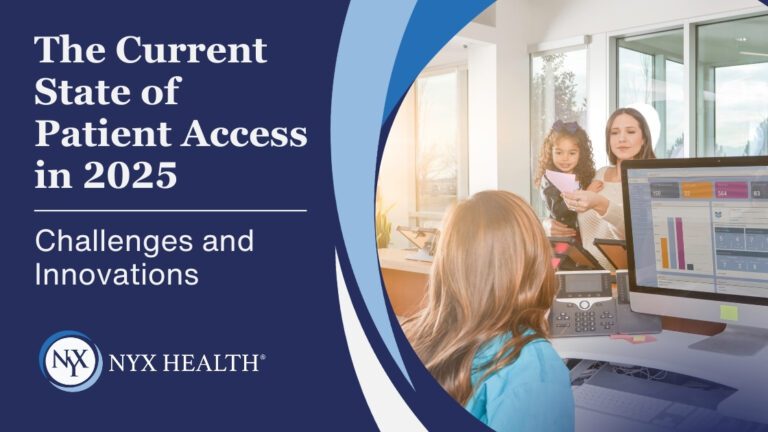The Current State of Patient Access in 2025: Challenges and Innovations

Patient access will remain a top priority for healthcare providers, payers, and policymakers in 2025. As the industry continues to evolve, improving access to care has become essential for reducing disparities, enhancing patient satisfaction, and driving better health outcomes. Despite technological advancements and policy changes, significant challenges persist. However, innovative solutions are reshaping the patient access landscape, offering new opportunities for providers and patients.
The Challenges of Patient Access in 2025
1. Administrative Burdens and Delays
Many patients still face barriers due to complex prior authorization processes, scheduling difficulties, and insurance verification delays. The inefficiencies in revenue cycle management contribute to prolonged wait times and frustration for providers and patients (American Medical Association, 2024).
2. Healthcare Workforce Shortages
A shortage of healthcare professionals, particularly in rural areas, continues to limit timely access to care. Physician burnout and staffing challenges exacerbate the issue, making it difficult for healthcare organizations to meet patient demand efficiently (Association of American Medical Colleges, 2024).
3. Digital Divide and Health Equity Concerns
While telehealth and digital health platforms have expanded access to care, disparities persist among patients who lack access to high-speed internet, digital literacy, or the necessary devices. This digital divide disproportionately affects low-income and elderly populations (Office of the National Coordinator for Health IT, 2024).
4. Financial Barriers
Even with value-based care initiatives and alternative payment models, out-of-pocket costs remain a significant hurdle for many patients. High-deductible health plans and rising prescription drug prices continue to impact affordability and adherence to treatment (Kaiser Family Foundation, 2024).
Innovations Transforming Patient Access
1. AI-Driven Automation in Revenue Cycle Management
Artificial intelligence and machine learning are streamlining administrative processes, such as prior authorizations and insurance eligibility checks. These advancements reduce delays, improve efficiency, and allow providers to focus more on patient care (Health IT Analytics, 2024).
2. Expansion of Virtual Care and Remote Patient Monitoring
Telehealth services have evolved beyond basic video consultations to include AI-powered diagnostics, wearable technology, and remote patient monitoring. These innovations are particularly beneficial for chronic disease management and post-acute care (American Telemedicine Association, 2024).
3. Retail and On-Demand Healthcare Models
Retail clinics and mobile healthcare services are increasing accessibility by bringing care closer to patients. Large retail chains, pharmacy providers, and even big tech companies are investing in healthcare delivery, offering convenient options for minor illnesses, vaccinations, and preventive care (McKinsey & Company, 2024).
4. Improved Patient Engagement and Self-Service Tools
Patient portals, AI-driven chatbots, and mobile health applications empower patients to schedule appointments, access medical records, and receive real-time assistance. These tools enhance transparency and reduce administrative burdens on healthcare staff (Healthcare IT News, 2024).
5. Policy and Payment Reforms
Federal and state policies are increasingly focused on reducing administrative barriers, incentivizing value-based care, and expanding Medicaid and Medicare benefits. Price transparency initiatives and surprise billing protections are also improving financial access to care (Centers for Medicare & Medicaid Services, 2024).
The Future of Patient Access
While challenges remain, the healthcare industry in 2025 is making strides toward a more patient-centric and accessible system. The integration of AI, digital health solutions, and policy reforms is paving the way for a more efficient and equitable healthcare experience. Healthcare organizations that embrace these innovations will be better positioned to enhance patient satisfaction, improve outcomes, and streamline operations in the years ahead.
At NYX Health, we are committed to helping providers navigate these changes by offering solutions that optimize patient access, reduce costs, and improve efficiency. Contact us to learn how we can support your organization in addressing today’s patient access challenges.
References
- American Medical Association (2024). “Prior Authorization Reforms and Their Impact.”
- Association of American Medical Colleges (2024). “The Growing Physician Shortage.”
- Office of the National Coordinator for Health IT (2024). “Bridging the Digital Divide in Healthcare.”
- Kaiser Family Foundation (2024). “The Rising Costs of Healthcare and Their Effect on Patients.”
- Health IT Analytics (2024). “AI in Revenue Cycle Management: Efficiency and Automation.”
- American Telemedicine Association (2024). “Trends in Telehealth and Remote Monitoring.”
- McKinsey & Company (2024). “The Future of Retail Healthcare.”
- Healthcare IT News (2024). “Patient Portals and Digital Engagement Tools.”
- Centers for Medicare & Medicaid Services (2024). “Healthcare Payment and Policy Reforms.”
Get Started Today!
Ready to simplify operations, boost revenue, and get back to what matters most—patient care?
Partner with NYX Health and experience the difference.
